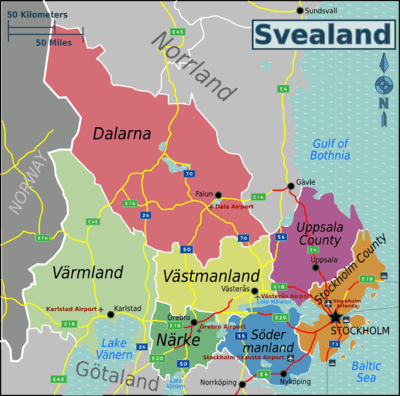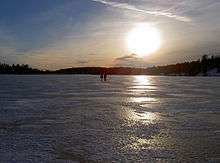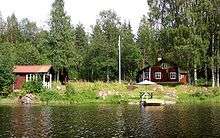Svealand
Svealand [ˈsveːaˈland] is the middle of the three lands of Sweden, between Götaland and Norrland. It is home to Stockholm, and a mixed landscape, with archipelagos and plains in the east, forests in the west, and snowy mountains in the north.
Provinces
Sweden is divided between traditional provinces, landskap, and modern counties, län; sometimes but not always coinciding. These are used interchangeably on Wikivoyage.

| Dalarna (Dalabergslagen, Siljansbygden and Västerdalarna) A province known for many icons of Swedish folk culture, such as Midsummer celebration and the Dala Horse. Snowy mountains with ski resorts. |
| Närke (Örebro, Kumla, Hallsberg, Askersund) A fertile plain in Sweden's demographic centre. |
| Södermanland County (Nyköping, Eskilstuna, Katrineholm, Strängnäs and Mariefred) A varied landscape of manors, farms, lakes and forests. |
| Stockholm County (Stockholm, Stockholm archipelago, Ekerö, Södertälje, Södertörn, Norrort and Norrtälje) The capital's urban area spans across the maritime parts of Uppland and Södermanland provinces, including several Royal Palaces, thousands of archipelago islands, city life, and quiet countryside. |
| Uppsala County (Uppsala, Östhammar, Tierp, Älvkarleby, Knivsta, Enköping) Contains most of Uppland, with fertile plains, and the cradle of the Swedish nation in the millennial city of Uppsala. |
| Värmland (Karlstad, Värmlands bergslag, Hagfors, Arvika, Kil) Deep forests and elongated lakes, known for storytelling, by writers such as Selma Lagerlöf and Gustav Fröding. |
| Västmanland (Västerås, Arboga, Hällefors and Grythyttan, Norberg, Fagersta) A forested province containing much of the traditional Bergslagen mining district. |
Cities
.jpg)
- 🌍 Stockholm is Sweden's capital and largest city.
- 🌍 Falun is a skiing centre known for the copper mine in the middle of the city.
- 🌍 Karlstad is an industrial city at lake Vänern.
- 🌍 Strängnäs and Mariefred are Medieval cities with a heritage railway and Gripsholm Castle.
- 🌍 Mora is a small town in Dalarna, with the home of realist painter Anders Zorn, and the finish line of Vasaloppet.
- 🌍 Nyköping is a medieval city, and the gateway to the world, with the Oxelösund port and Skavsta airport.
- 🌍 Uppsala is a university city with a thousand years of history, back to the Viking age.
- 🌍 Västerås is Sweden's fifth largest city; founded in AD 990, today known for robotic industry.
- 🌍 Örebro has an impressive castle.
Other destinations
|
Bergslagen, the cradle of Swedish metal industry Bergslagen is a loosely defined region which contains Västmanland, and parts of neighbouring provinces: Dalabergslagen in southern Dalarna, Värmlands bergslag in eastern Värmland, Närke, Uppland, and Södermanland. Since prehistoric times, and most prominently during the 17th century Swedish Empire, the area was a powerhouse of mining and metal industry, with advanced technology for its age. Today, only a few mines and industries remain operational, but many of them are preserved. |
- Bergslagen, consisting of Västmanland, Dalabergslagen and Värmlands bergslag
- Ekerö, Stockholm's freshwater archipelago, contains Drottningholm Palace and Viking Age settlement Birka.
- Grythyttan, a quaint mining town with a culinary academy.
- Leksand, known for Midsummer celebration, hard bread, and ice hockey.
- Siljansbygden, in central Dalarna, is an archetype of Swedish folk culture.
- Stockholm archipelago has thousands of islands.
- Sigtuna, Sweden's capital from 11th to 13th century.
- Sälen, a ski resort.
- Älvdalen, the northern edge of Svealand, with tall mountains.
Understand
- See also: Vikings and the Old Norse, Nordic history

The natives of Svealand named themselves svear, called Suiones by Roman historians. While lake Mälaren used to be part of the Baltic Sea, it was the base of Old Norse culture, and some of the inhabitants travelled far overseas: the Vikings. In the 11th century, Svealand was Christianized, and united with Götaland, to form Sweden, with Sigtuna, Uppsala and later Stockholm as a centre of power. In modern times, Svealand hardly has any role as a cultural identifier. If Swedish people are ever patriotic, it is usually for their province or city.
In the 16th century, the soon-to-be king Gustav Vasa took refuge in the province Dalarna to avoid the Danes, who had massacred 80 Swedish noblemen on the Great Square in Stockholm. Here he got support from the peasants, and formed an uprising. He contracted German mercenaries, and finally liberated Stockholm.
The Swedish metal industry rose during the 17th century, with aid from Walloon craftsmen. The Industrial Revolution saw the foundation of several big corporations, such as ASEA (now ABB), and AGA. During the 20th century, many small inland towns have been depopulated and deindustrialized, while Stockholm is one of Europe's fastest-growing cities.
Get in
Stockholm-Arlanda Airport ARN IATA (Sigtuna), Stockholm-Skavsta Airport NYO IATA (Nyköping) and Stockholm-Bromma Airport BMA IATA (Stockholm/Västerort) are major international airports in Svealand.
The airports in Oslo (Oslo Airport, Gardermoen, Moss and Sandefjord) might also be useful.
Baltic Sea ferries arrive in Stockholm, Nynäshamn and Kapellskär, from Åland, Finland, Estonia and Latvia.
National rail carrier SJ runs trains from Oslo and Copenhagen to Stockholm.
Get around
There are several rail and bus lines serving the area (see rail and bus in Sweden). Roads are in good condition (see driving in Sweden).
See

Glamorous cities such as Stockholm, Uppsala and Västerås, as well as quaint villages with rich folk culture, and great lakeside views.
Do
Though there are plenty of forests in Svealand, even around Stockholm, the nearest village is rarely more than ten kilometres away. This makes Svealand good for outdoor life, such as hiking, winter sport, and swimming.
Go next
- Gotland, Sweden's largest island.
- Åland, a Swedish-speaking autonomous island-province, which is part of Finland.
- Norway